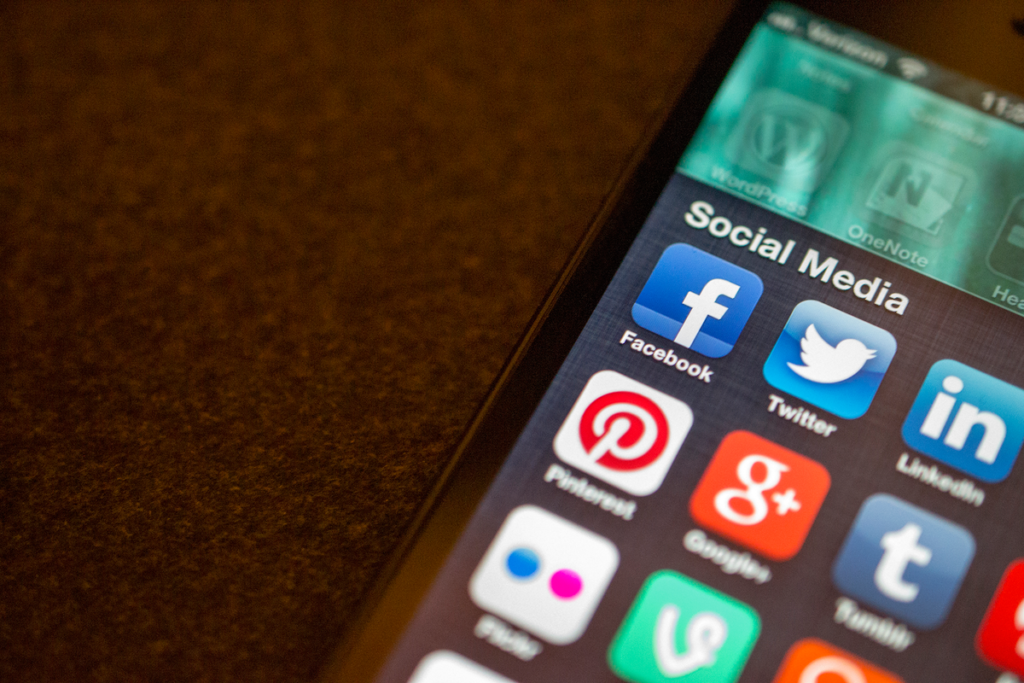Once a revolutionary invention and now a multi-generational disasterpiece, post-Facebook social media applications fight for our undivided attention in a world full of short attention spans. Meanwhile, these same platforms claim to capture reality through a medium that makes that impossible. Many users find themselves compulsively using these apps without feeling like they’re gaining anything worthwhile from them.
Generation Z is the first generation to grow up in this hyper-digital environment. That’s my generation. We’re sitting in front of televisions and computers constantly, yes, but it doesn’t end there. Most kids I know got their first phone as early as middle school. We’re not just raised with “Sesame Street” or “Wild Kratts,” but with apps that strategically coerce people to share every single aspect of their lives with “friends” we may barely know in-person.
I feel constantly pressured to share more and react to tragedies that go viral. I scroll through hours worth of TikTok and Instagram “reels” instead of doing homework, reading, or even spending time with family. It’s the ultimate distraction, comforting in a shallow manner but not anything genuine in the end. I’m not above this culture, no one really is. I try to limit my screen time when necessary, but I am fascinated by Instagram and Snapchat among many other apps. They catch my attention effortlessly, addicting on a ridiculous level.
“Social media platforms drive surges of dopamine to the brain to keep consumers coming back over and over again,” said Dr. Nancy Deangelis, the Director of Behavioural Health at CRNP. “The shares, likes and comments on these platforms trigger the brain’s reward center, resulting in a high similar to the one people feel when gambling or using drugs.”
Just put the phone down, right? Closing the app and shutting the phone off are two very simple actions, but they’re not easy ones. It’s the endorphins I receive from red-colored notifications indicating a like or a follow, the obsessive-compulsive desire to click on the next friend’s story. What’s he up to tonight? What meme or trend has gone viral recently, what’s gone quiet?
“By giving people the power to share, we’re making the world transparent,” said Mark Zuckerberg concerning the purpose of Facebook.
That’s a rich statement coming from an app where misinformation got six times more clicks than factual news during the 2020 election. I find myself cautious with most social media, but Facebook in particular.
Few my age use Facebook, but the platform’s irrelevancy to my generation is not what truly bothers me. It’s an app for adults, everyone knows that. It’s the fact that it’s a hub for misinformation that ticks me off. News that can cause widespread, false belief due to its sheer platform and influence. Now, in Facebook’s defense, it’s not the only app that promotes fake news, far from it. But according to Forbes, no other app spreads fake news as fast as Facebook does.
Jack Dorsey, Evan Williams, Noah Glass and Biz Stone founded Twitter on March 21, 2006 in California. Unlike Facebook or Instagram, Twitter’s purpose is less sharing photos and digitally communicating and more provoking public conversation on politics, news and media in general.
In my experience, the app is a cesspool for toxic arguments and mob mentality. It’s painfully difficult to find a singular tweet without constant conflict and hate in the comments section, largely promoting a negative atmosphere.
“To give everyone the power to create and share ideas and information instantly, instantly, without barriers,” reads the app’s mission statement.
It’s unfortunate that many of these “ideas” Twitter ends up promoting are hate speech. Since Elon Musk purchased Twitter in 2022, The New York Times reports that bigotry on the app has exponentially increased.
Slurs against Black Americans increased from 1,282 times a day to 3,876 times a day after the purchase. Slurs against gay men rose from 2,506 times a day to 3,964 times a day. The amount of daily antisemitic posts referring to Jews and Judaism also rose following Musk’s takeover, by more than 61% in two weeks.
Besides the fact that Twitter has been deeply problematic since its inception, it’s also an anxious app full of anxious people, most of whom are looking to create chronic anxiety within others. There are updates every second of the day–new opinions dropping and arguments over those opinions following suit. It’s like a neverending livestream of news written by imbecilic children thinly hidden behind the veil of “discourse” and “free speech.” It’s terrifying, and an unrelenting, heavily addicting drug. But unlike most other social media services I’ve had, the drug failed to give me that digital validation so many of us crave.
Instagram launched on October 6, 2010. In one day, it amassed 25,000 users. Facebook purchased the app in 2012 for one billion dollars. Today, I’m among the billions of users.
I’m a regular Instagram user. I’ve had the app for at least three years now–and it’s an undeniably addicting one. From its consistent hammering of users with notifications and content from “mutuals,” you can show your digital appreciation of someone with anything here. Posts, stories, messages–and a pointless update that allows you to share “daily thoughts” overlaid on your profile picture. So many, including myself, are pressured into sharing everything, filtered or unfiltered.
According to a 2020 “internal Instagram presentation,” The Wall Street Journal saw that 32% of teenage girls were uncomfortable with their own bodies, citing that Instagram only made them feel worse. The Wall Street Journal additionally discovered that among teenage users who were experiencing suicidal thoughts, 6% of American teens traced their feelings to Instagram.
Instagram has allowed me to digitally connect with many friends, those who I still go to school with everyday and those who I moved away from years ago. It connects everyone and everything, for better or for worse. It’s also an undeniable enabler of our inherent human nature of comparing ourselves to others.
The interesting aspect of social media and its evolution is the fact that it’s constantly transforming and reacting to us. Each sequential app fights for our attention in a newly manipulative, successful manner.
Instagram provided a new area for digital communication, but its content largely rang (and still rings) artificial. Beyond teenage girls concerned about body image or the vast amount of posed, unrealistic photos–I only find that the app promotes a sanitized, clean filter over our lives, masking poor mental health behind the veil of a beaming smile.
This painful truth reared its ugly head recently when Ellen DeGeneres’ former DJ, Stephen “tWitch” Boss, comitted suicide on December 13, 2022. In addition to his position on “The Ellen DeGeneres Show,” Boss was a freestyle hip hop dancer and choreographer with a prominent presence on social media. (tWitch had over four million followers on Instagram).
As I examine each Instagram reel (15-30 second video) Boss posted, his suicide baffles me further. In almost every video, Boss puts up a convincing mask. He appears effusive and energetic, but looking at the captions, most posts have nothing to do with his personal life. Boss is nearly universally seen advertising and using his platform to promote other companies through dance. His account is a testament to how little social media shows someone’s real life. When online, you don’t know the person, you know a persona that person thinks other users will accept.
Snapchat launched less than a year after Instagram. Developers Evan Spiegel and Bobby Murphy created an app that celebrated spontaneity and recklessness in users. It’s primarily an app for messaging, but the messages are generally sent visually–with pictures of yourself. The point is to capture a singular moment of your day. Yes, the filters are more or less a contradiction of the app’s “mission statement,” but the strategy worked like a charm–particularly with teenagers.
Over 210 million “snaps” are sent every day. In 2022, nearly 500 million people worldwide are using the app. In more than 20 countries, Snapchat reaches 90% of the 13 to 24 year-old population. The third statistic is what really catches my eye.
Snapchat is undeniably the app that grabs my generation’s attention the most. It appeals to our adoration for temporary, spontaneous communication, only further kindling the fire of teenage risk-taking. The app isn’t there to record history or memories, but small moments that vanish in an instant (unless explicitly “saved” in the chat). The selectivity of Facebook and Instagram is largely replaced by a sense of rawness in the communication.
Snapchat’s spontaneity is an advantage no other social media app has. As mentioned, if a photo is not immediately saved in the chat by a user, it vanishes in an instant. In terms of other messaging apps, Messages, Facebook and Instagram lack this feature (unless someone deletes the message), which discourages risky discourse. Snap, on the other hand, seduces users into provocative communication, visually or with text.
Snapchat is very focused on catering to our endorphins. Whether that’s “Snap streaks” (a number that indicates how many days you have been snapping another user in a row), small emojis next to the person you’re communicating with (from a red heart meaning they’re your BFF – you snap with each other the most – to a birthday cake indicating it’s their birthday). The app shares everything with everyone, a recurring theme in social media. Then there’s the literal Snap map that, if allowed, shows your exact location at all times for every one of your “friends” to view–but that seems rather small in the scheme of things.
More than anything, like most social media apps, Snapchat encourages pressure and competition between users. I constantly feel teased by the Snap streaks. The feeling that I have to send a picture of myself to another user daily or I’ve failed a task that only social media creates. Fighting for that BFF heart emoji that shows you’re digitally closest with another as they are with you–it creates a toxic mentality in myself and many others. A Snap score that publicly displays how many snaps you’ve sent and received leering over you as a popularity marker. It’s all competition, and one way or another, these features always work their way into my headspace.
In terms of social media evolving based on a response-to-people mechanism, TikTok represents an equally unfortunate truth about humans: our desperately short attention spans.
The average attention span for someone born in Gen Z is reported to be about 8 seconds. That creates an easy path into our digitized culture for something like TikTok, an app bolstered by its short, digestible videos. Personally, I find it difficult to sit through an episode of television without feeling the need to pick up my phone and scroll through TikTok instead. The videos are quick and simple, without requiring too much effort to understand. No wonder over 60% of TikTok’s users are part of Gen Z.
Social media is still an influential part of our culture, but it’s also bordering on self-parody nowadays. An app literally called BeReal has found its way into our digital ecosystem. Taking pride in itself for being even more spontaneous and “real” than an app like Snapchat, BeReal only allows a small amount of time per day to post a picture of yourself and your surroundings. It’s successful in the sense that it disallows posing and preparation in photographs, but it’s still only a reflection of our desperate need to capture reality on a fake internet platform.
In the toxic, day-ruining clusterf–k that is social media, what’s the point of keeping it? It’s difficult for me to pinpoint why I still have several of these apps downloaded, and why I struggle to be off of them for more than 20 minutes at a time. The fear of missing out, or FOMO, is a significant factor for me. It’s the sense that I’m missing out on trending events or ignoring my friends if I don’t constantly check for Instagram and Snapchat updates. It’s a crippling pressure, holding my eyes to the screen and providing the nutrients to keep these services running.
The irony is that the most positive I’ve felt while using social media is on Spotify, an app for listening to music. It allows followers, user collaborations and likes on playlists, but I’ve never felt a competitive, braggy atmosphere. Three followers or hundreds, it’s just about the music.
Photo: “Social Media” by Jason Howie is licensed under CC BY 2.0





This is a very compelling subject, and an interesting read! You’ve put into words what many of us feel about these social media platforms. We have such a Love vs. Hate relationship with them all. We are pretty much all in agreement that we HATE social media….AND yet we love them, keep them, keep checking them…to our own detriment. Further, what an interesting fact that I hadn’t heard before but makes sense…If the average teen’s attention span is only 8 seconds, no wonder it’s hard to commit to and complete goals and/or projects that might require long-term effort.